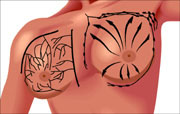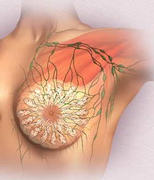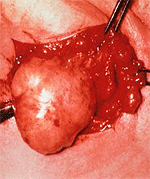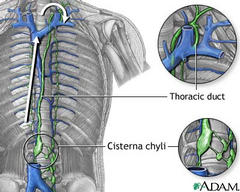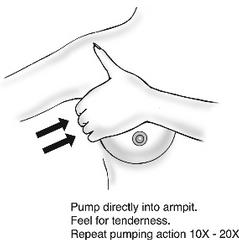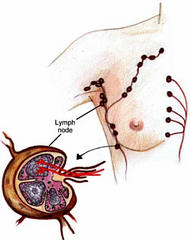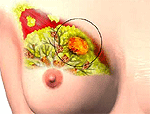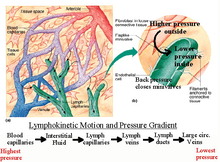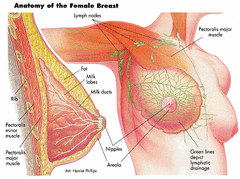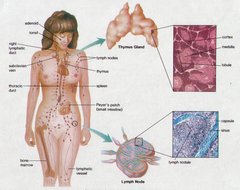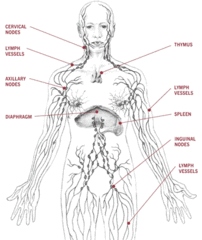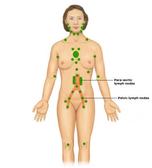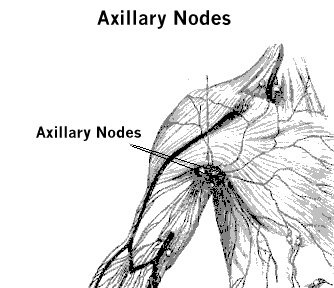Medical Photos
Medical Photos
Breast Massage
by author Dietmar Hartl and Robin Cunningham, LMT
 Very few women are truly familiar, and comfortable, with their breasts. Yet breasts are considered to be one of women’s most beautiful physical assets.
Very few women are truly familiar, and comfortable, with their breasts. Yet breasts are considered to be one of women’s most beautiful physical assets.
Despite the airbrushed images seen in ads and the media, there’s no one universal breast type that’s considered "better" than the rest. All breasts are largely composed of fatty tissue. Some women have more, some have less. The size, shape, firmness and skin texture are initially "set" by genetic background and vary among different cultures and individuals. Then, after birth, nutrition and exercise habits influence how breasts develop.
The path to improving your understanding of breast health and becoming more comfortable with that part of your self is breast massage. The central European culture is familiar with lymph drainage and pregnancy breast massage. In Japan, women and couples learn breast massage in some hospitals and receive a certificate for it. Breastfeeding mothers familiar with La Leche League, the mothers’ breastfeeding support group, may also use it.
According to Katharina Wehrli, bodyworker since 1977, gentle breast massage regulates the menstrual cycle, eases menstrual cramps, reduces breast soreness due to hormonal fluctuation and tones and firms the breasts. Breast massage also stimulates lymph flow. According to Sidney Ross Singer and Soma Grismaijer, authors of Dressed to Kill (Avery, 1995), bras worn more than 12 hours a day increase the risk of breast cancer because they constrict the lymph glands (located at the sides of the breasts and just underneath the armpits), causing toxins to accumulate in breast tissue. Breast massage helps relieve toxin buildup and encourages blood circulation for a healthy lymphatic system and decreased risk of breast cancer.
Self-Help Technique
Breast massage can be added easily to regular breast self-exams. You can learn massage yourself, enrol with a trusted ally or visit a massage therapist or bodyworker.
It’s simple to learn. One key point: Be gentle and soft with your touch! Paula Jaspar, RMT, outreach director at the West Coast College of Massage Therapy in New Westminster, BC, advises, "Use touch as light as you would on an eyelid."
Choose a warm place that is calm and quiet, with subdued lighting. When you close your eyes, focus your senses on the physical structures you’re feeling with your hands and on what your emotions are saying. It can be disconcerting at first to explore your breasts if you’re not used to doing so, but it can also be a powerful healing experience.
Massaging your own breasts takes only about five to 15 minutes and should be done two to three times per week. The pressure should be light, applied with the full palm or the underside of the fingers. For lymphatic drainage, it takes very little pressure (think of the weight of a sheet of paper) to move lymph fluid through breast tissue.
Some useful massage techniques include small circular strokes, moderate compressions, kneading motions, lifting and pressing and light lymph compression.
Step One
Using the hand opposite the breast you want to massage, begin by gently applying moderate-pressure circular strokes, radiating out from the nipple and working into the underarm as well as to the centre of the chest (sternum).
Step Two
Move your fingers around your breast in a gentle motion. In the shower or bath you can do this by merely lubricating your fingers with a bit of soap to make gliding easier.
Step Three
Gently massage by kneading each breast, using lifting and slightly compressive movements. Include moderate-pressure compressions to move stagnant fluids out of the breast. You can also gently twist each breast, using both hands, in a wringing motion.
Step Four
Use the flat underside of your fingers with a broad contact to gently but firmly scoop and lift the tissues beginning from the underarm area and moving in a clockwise, or counterclockwise, direction, with medium pressure directed toward the nipple. Massage the circumference of each breast this way.
Step Five
Your fingers will easily locate the "indents" between your breasts. In the middle is your sternum or breastbone. On either side of it you can feel the ribs and then the "valleys" between them. Place your fingertips in these valleys.
Starting with your right hand, using your fingers spread apart, follow the grooves of your ribs from the sternum (centre line), beginning just below your collarbone, moving outward toward your right breast one or two inches. Gradually shift your position, working your way down the sternum, following the rib grooves out as far as is comfortable. Repeat on the left side.
During your sessions, you may repeat these massage therapy movements up to two or three times each, if you wish. You can use this starting sequence for self-massage, or for working with a partner.
Paula Jaspar RMT, instructor in breast massage, recommends the book Breast Massage by Debra Curties; she also notes that taking a towel or cloth diaper that has been soaked in warm water and wrung out, wrapping it over and around the breast, allowing the nipple to show, as an excellent way to "massage" the breast with warmth while breastfeeding..
Conclusion
Explore the healthfulness of breast massage by yourself or with a comfortable partner or practitioner. For guidance, refer to a book, video or Web site, or enrol in a workshop. Quiet, patient practice, and adding some hydrotherapy, will give you great benefits: a feeling of increased awareness, self-confidence, and competence in knowing what your breasts are all about. Breast massage, like all health-giving massage, is good for body and spirit!
